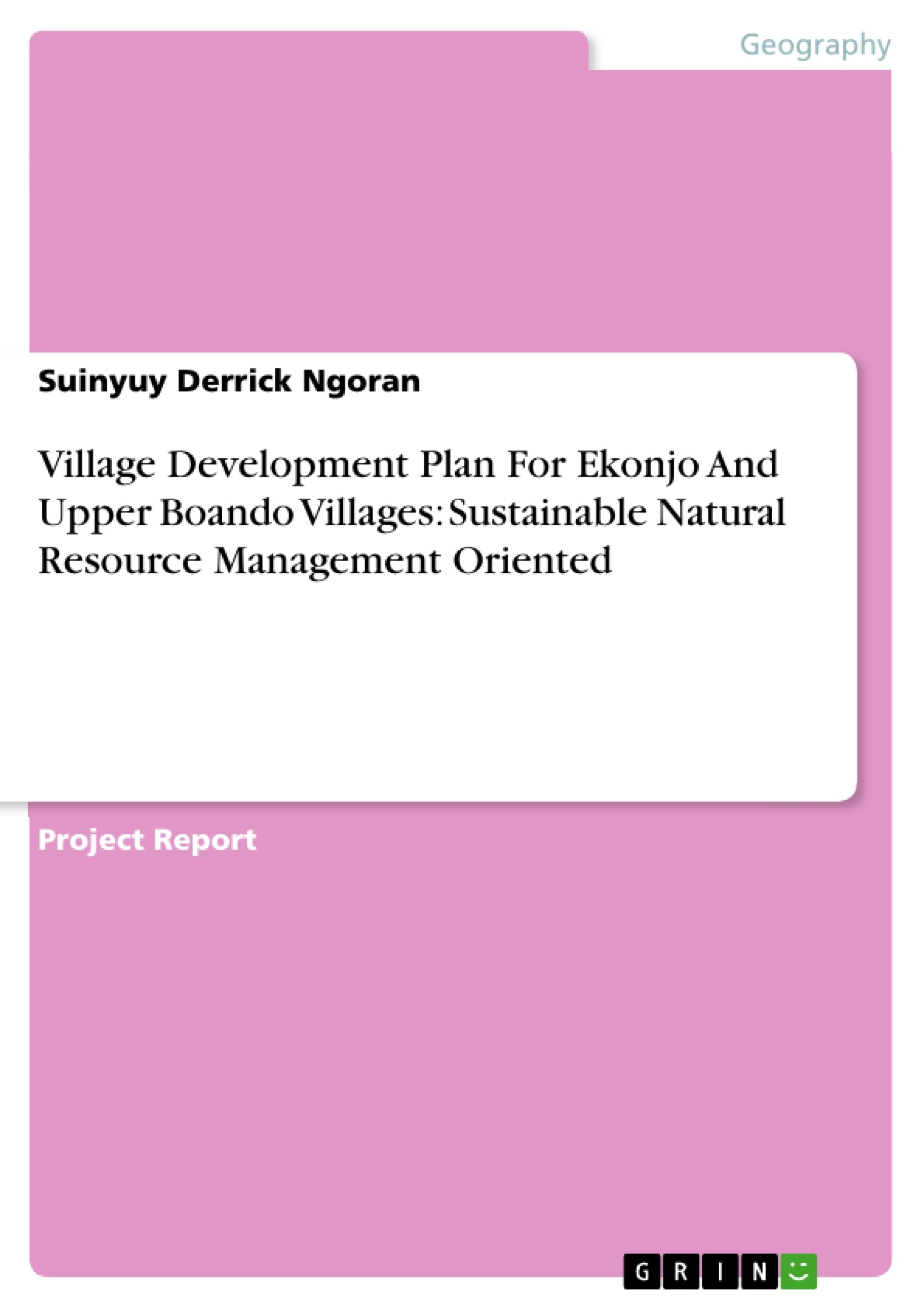A village development plan is a document that outlines clearly development procedures prepared by a village that can be used to mobilize potentials, capacities and allocation of resources. The goal is to move a village from its present situation to a desired one in an orderly and acceptable manner within a given time frame. It is a systematic approach that aims at sustainable management of natural resources and livelihood development at the village level. It is aimed at creating an environment for investors of the village in the long run.
The purpose of the exercise was to guide the two villages prepare a development plan in a cluster fashion. A manual (including the different participatory and learning tools and methods) prepared by the PSMNR-SWP through its lead partner responsible for result 4 - DED was used throughout the planning process. The specific objective of the assignment was to assist the villagers find solutions for CBNRM strategies that shall contribute to improving livelihood as well as smaller infrastructure projects (demand driven), also find solutions for communal forest management activities and finally include within the VDP, a “Package” of priority interventions recommended for implementation through the PSMNR-SWP.
The development planning process of Ekonjo and Upper Boando villages lasted a total of ten days. In each village, five days were spent so as to assess the base situation and document the strengths, potentials and problems for development. In the last two days, joint meetings were organized to finally select and prioritized the projects for the two villages, and also come out with a strategic and annual implementation plan and a monitoring and evaluation plan.
Ekonjo and Upper Boando villages are found in Buea municipality, located within the Buea Sub-division in Fako Division of the South West Region. Upper Boando and Ekonjo villages are quite small villages in terms of population sizes. Ekonjo village has a total of 104 persons with 54 of them permanently residing in the village and 50 outside. Upper Boando on the other hand has 77 persons, 26 of them residing in the village and 51 outside.
The main economic activity of the two villages is farming and the most important crops cultivated are plantain and banana. For Ekonjo, average revenue generated from plantains per household per year is 158,000 FCFA and for Upper Boando is 328,000 FCA.
Table of Contents
LIST OF TABLES
LIST OF ANNEXES
LIST OF ACRONYMS
EXECUCTIVE SUMMARY
SECTION 1: REPORT ON ASSESSMENT
CHAPTER 1: INTRODUCTION
1.1 Location
1.2 Accessibility
1.3 Population sizes and structure of the villages
1.4 Climate and vegetation
1.5 Livelihood activities
1.6 Development concerns and potentials
1.7 Objectives
CHAPTER 2: SOCIOECONOMIC BASELINE SURVEY
2.1 Population (sex, age, ethnic group)
2.1.1 Ethnicity
2.1.2 Age and sex ratio
2.2 Historical analysis
2.3 Time line
2.4 Sources and levels of income
2.5 Areas of expenditure
2.6 Village institutions and organisation
2.7 Natural resources management authorities
2.8 Social amenities (water, school, health facilities etc.)
2.9 Social problems
2.10 Interaction with other villages
2.11 Past and current development projects and partners involved
CHAPTER 3: LIVELIHOOD ACTIVITIES
3.1 Plantain and banana farming
3.2 Cocoyam farming
3.3 Pepper
3.4 Vegetables
3.5 Maize
3.6 Fruits
3.7 NTFP gathering
3.8 Animal husbandry
3.9 Timber exploitation
3.10 Coffee and oil palm production
3.11 Particular activities and the months when they occur
CHAPTER 4: PARTICIPATORY LAND USE MAP AND TENURE
4.1 Participative land use mapping
4.2 Land tenure system
CHAPTER 5: HUMAN AND PROTECTED AREA INTERACTION
5.1 Awareness of existing conservation issues or protected areas
5.2 Local perceptions and attitudes
5.3 Impact of existing livelihood activities on natural resources
5.4 Eistence of animal/human conflicts
5.5 Existence of conservation mechanisms and relationship with MINFOF
SECTION 2: REPORT ON PLANNING
CHAPTER 6: NEED ASSESSMET and OUTLINE OF PRIORITY PROJECTS
6.1 List of problems identified by Ekonjo and Upper Boando
6.2 List of solutions identified for Ekonjo and Upper Boando
6.3 Village development goals
6.4 Priority development objectives based on PSMNR objectives
6.4.1 CBNRSM (towards conservation of natural resources)
6.4.2 CBNRSM and income (NTFP and agriculture)
6.4.3 Infrastructure & livelihood
6.5 The Ekonjo and Upper Boando shared vision
CHAPTER 7: PLANNED ACTIVITIES and OUTLINE OF PRIORITY PROJECTS
7.1 Selected priority projects based on impact ranking
CHAPTER 8: CONCLUSION
CHAPTER 9: RECOMMENDATION
ANNEX 1 - 15
- Citation du texte
- Suinyuy Derrick Ngoran (Auteur), 2009, Village Development Plan For Ekonjo And Upper Boando Villages: Sustainable Natural Resource Management Oriented, Munich, GRIN Verlag, https://www.grin.com/document/269169
-

-

-

-
Téléchargez vos propres textes! Gagnez de l'argent et un iPhone X. -

-
Téléchargez vos propres textes! Gagnez de l'argent et un iPhone X. -

-
Téléchargez vos propres textes! Gagnez de l'argent et un iPhone X. -

-
Téléchargez vos propres textes! Gagnez de l'argent et un iPhone X. -

-
Téléchargez vos propres textes! Gagnez de l'argent et un iPhone X. -

-
Téléchargez vos propres textes! Gagnez de l'argent et un iPhone X. -

-
Téléchargez vos propres textes! Gagnez de l'argent et un iPhone X. -

-
Téléchargez vos propres textes! Gagnez de l'argent et un iPhone X. -

-
Téléchargez vos propres textes! Gagnez de l'argent et un iPhone X. -

-
Téléchargez vos propres textes! Gagnez de l'argent et un iPhone X. -

-
Téléchargez vos propres textes! Gagnez de l'argent et un iPhone X. -

-
Téléchargez vos propres textes! Gagnez de l'argent et un iPhone X. -

-
Téléchargez vos propres textes! Gagnez de l'argent et un iPhone X. -

-
Téléchargez vos propres textes! Gagnez de l'argent et un iPhone X.

